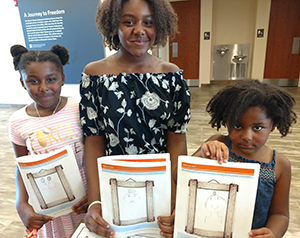Points of Interest at the Park
President Barack Obama issued a proclamation on March 25, 2013, declaring the land on Maryland’s Eastern Shore, where Tubman was born, lived and traveled, as a national monument and set the stage for the National Historical Park Designation. On December 19, 2014, the President signed into law H.R. 3979, which was authorized the creation of the Harriet Tubman Underground Railroad National Historical Park. Together, the national historical park and monument will preserve the unique landscape associated with Harriet Tubman's life on the Eastern Shore.
Visit the Harriet Tubman Underground Railroad National Historical Park's website at:
https://www.nps.gov/hatu/index.htm.

Harriet Tubman Underground Railroad Junior Rangers

Understanding and appreciating our history is important for reflecting upon ourselves in the present day. We aim to teach Junior Rangers about Harriet Tubman's life and legacy, and the importance of the Underground Railroad. Harriet Tubman Underground Railroad State Park offers two different Junior Ranger activities: one that focuses on Harriet Tubman’s life and legacy and the second on the art and music found in the Visitor Center.
Click here to view the Harriet Tubman Underground Railroad Visitor Center Junior Ranger Activity Book.
Click here to view the Sights and Sounds of Freedom Junior Ranger Activity Book.
The Original Junior Ranger Activity: Start your experience by requesting a self-guided activity book at the Visitor Services desk. Use the exhibits and your personal experiences to complete the booklet and build a personal connection to Harriet Tubman and the Underground Railroad. The information in the back is neither sanitized nor watered down for our audience. The Original Junior Rangers is intended to help our younger guests learn the information in the exhibit hall. Though its intended audience is primarily that of children, teenagers and adults have completed our award-winning booklet with zeal and passion. The activity book takes you throughout the exhibit space and has you answer questions using the knowledge you gain on your journey. Once completed, the new Junior Ranger will get sworn in and receive a patch marking their completion.
 Sights and Sounds of Freedom Junior Ranger Activity: Start your experience by requesting a self-guided activity book at the Visitor Services desk. With this activity booklet, the focus is shifting to the sights and sounds that influenced the creation of the park and the Visitor Center. Art and music tell much of Harriet’s legacy in a way that simple words have trouble encapsulating. The Sights and Sounds of Freedom Junior Ranger Activity has guests focus on the many artistic aspects of the Visitor Center and encourages them to open themselves up and feel the energy of the park. Because of the abstract nature of art and music, this activity booklet is intended for a more mature audience. The booklet will guide guests throughout the exhibit hall, and will challenge them to interpret the exhibit in their own way. Once completed the new Junior Ranger will get sworn in and receive a patch marking their completion.
Sights and Sounds of Freedom Junior Ranger Activity: Start your experience by requesting a self-guided activity book at the Visitor Services desk. With this activity booklet, the focus is shifting to the sights and sounds that influenced the creation of the park and the Visitor Center. Art and music tell much of Harriet’s legacy in a way that simple words have trouble encapsulating. The Sights and Sounds of Freedom Junior Ranger Activity has guests focus on the many artistic aspects of the Visitor Center and encourages them to open themselves up and feel the energy of the park. Because of the abstract nature of art and music, this activity booklet is intended for a more mature audience. The booklet will guide guests throughout the exhibit hall, and will challenge them to interpret the exhibit in their own way. Once completed the new Junior Ranger will get sworn in and receive a patch marking their completion.
Tubman Experience
The visitor center's exhibit hall is a self-guided experience, however, rangers are available for a ranger-led introduction to the park and groups, as well as a Junior Ranger overview and explanation. With advance notice, groups may request ranger-led tours or interpretive programs. Offer valid only when services are available.

Eastern Shore Explorers Program
Journey across the Eastern Shore and uncover the storied past of the region's African American community in the new Eastern Shore Explorers program. From the historic city of Cambridge and the vibrant history of its Second Ward to checkpoints of the Underground Railroad hidden in the countryside, learn and explore moving ever toward freedom.
Visit the
Harriet Tubman Underground Railroad Visitor Center to receive the Eastern Shore Explorers activity booklet, or click below. Once you receive the booklet, you and your team can choose to complete the urban or rural expedition (or both!). Visit historical landmarks pertaining to local African American history assigned in the activity booklet and answer questions. Once completed, return to the Visitor Center and receive your Eastern Shore Explorers certificate, patch, and pin! This activity is free.
Click here to view and print the Eastern Shore Explorers Activity Book
BARK Rangers

Your pet can become a BARK Ranger at Harriet Tubman Underground Railroad State Park. If you and your pet follow the BARK rules (Bag your pet's waste, Always use a leash, Respect wildlife, and Know where you can be) then you can earn a BARK Ranger dog tag and certificate! Walk your pet around our 3/4 of a mile trail through our Legacy Garden. Only Service Animals are allowed inside the Visitor Center.
